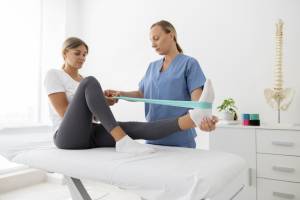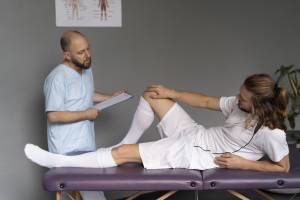Introduction to ACL Recovery
Recovering from an anterior cruciate ligament (ACL) injury is a journey that requires patience, dedication, and a clear understanding of the recovery process. ACL injuries are common, particularly among athletes, and can significantly impact daily life. Knowing what to expect can help you prepare both mentally and physically for the challenges ahead.
ACL recovery isn’t just about physical healing, it also involves a structured ACL rehab process. It also requires emotional and mental resilience. With the right mindset and support, you can navigate each phase effectively. From the initial injury to regaining full mobility and strength, each stage plays a vital role in your recovery. Whether you’re returning to sports or daily activities, understanding the recovery stages will help you make informed decisions and take proactive steps toward healing.
The Anatomy of the ACL and Common Injuries

The anterior cruciate ligament (ACL) is a vital component of the knee joint, providing stability and support during movement. Located in the center of the knee, it connects the thigh bone (femur) to the shin bone (tibia) and prevents the tibia from sliding forward, which is essential for balance during activities like running, jumping, and pivoting.
ACL injuries often occur due to sudden changes in direction or direct blows to the knee, especially in sports like soccer, basketball, and skiing. These injuries are a common cause of knee pains and can range from mild sprains to complete tears, with more severe cases typically requiring surgery.
Common symptoms include a loud “pop” at the time of injury, severe pain, swelling, and knee instability. Prompt medical attention is crucial to assess the damage and begin appropriate treatment. Early diagnosis can greatly improve recovery outcomes and reduce the risk of complications.
Stage 1: Initial Recovery-From Injury to Crutches
The initial recovery phase begins immediately after an ACL injury and focuses on protecting the knee, managing symptoms, and laying the groundwork for rehabilitation. Crutches are typically recommended to reduce weight-bearing on the injured leg, helping to ease pain and swelling, and even numbness of legs that can sometimes accompany the injury. Rest is essential to support the body’s natural healing process.
In the first few weeks, your main goal should be to control swelling and pain. Ice application, leg elevation, and prescribed medications can help manage these symptoms. A knee brace may also be used to stabilize the joint and prevent further injury. Following your healthcare provider’s guidance is vital to ensure proper healing.
Patience is key during this stage. While the restrictions can be frustrating, this phase is critical for setting a strong foundation for recovery. By following medical advice and performing gentle, approved movements, you’ll be better prepared for the more active rehabilitation phases ahead.
Stage 2: Rehabilitation Phase-Strengthening and Mobility
In the rehabilitation phase, you begin exercises to restore strength and mobility to your knee. This stage is essential for regaining function and preparing for a return to daily activities. Guided by a physical therapist, you’ll start with movements that improve range of motion and gradually progress to more advanced strengthening exercises.
Your therapist will design a personalized plan that may include leg lifts, knee bends, and resistance training to target muscles around the knee. Consistency is key, as regular exercise helps rebuild strength and prevent muscle atrophy caused by inactivity.
As you progress, your knee’s stability and function will improve. However, avoid rushing the process. Overexertion can lead to setbacks, so communicate any pain or discomfort to your therapist. With steady effort and adherence to your rehab plan, you’ll work toward full mobility and strength.

Stage 3: Transitioning to Conditioning-Building Endurance and Stability
Once you have made significant progress in the rehabilitation phase, you will transition to conditioning, which focuses on building endurance and stability. This stage is important for preparing your body to meet the demands of sports and daily activities. Conditioning exercises enhance cardiovascular fitness, agility, and overall strength, helping you resume an active lifestyle confidently.
During this phase, your physical therapist may introduce more dynamic exercises such as jogging, jumping, and lateral movements. These activities mimic sports motions and improve your knee’s ability to handle stress and impact. Balance and proprioception exercises are also emphasized to enhance muscular coordination and joint stability, reducing the risk of future injuries.
Common Challenges and How to Overcome Them
Recovering from an ACL injury involves several challenges like pain, swelling, and frustration with the pace of healing. These difficulties are a normal part of the process but can be managed effectively with the right approach.
Managing pain and swelling early on is crucial. Follow your healthcare provider’s advice, which may include medication, ice therapy, and elevating the leg. Staying consistent with your prescribed exercises also helps reduce stiffness and supports healing.
Motivation can wane during slow progress or setbacks. To stay on track, focus on small victories and celebrate milestones along the way. Keeping a journal to monitor your progress and setting realistic, achievable goals can boost your morale. It is also important to maintain a positive outlook throughout recovery. Surround yourself with supportive friends and family, and remind yourself that each day brings you closer to full recovery. Remember, recovery is a marathon, not a sprint—patience and persistence are key to success.

Conclusion
Recovering from an ACL injury is a challenging yet rewarding journey that requires perseverance, dedication, and a positive mindset. By understanding the stages of recovery and working closely with your healthcare team, you can navigate each phase confidently and achieve a successful outcome. Every step brings you closer to regaining strength, mobility, and independence.
Embrace the journey as an opportunity for growth and self-discovery. Celebrate your achievements, no matter how small, and stay focused on your goal of full recovery. With patience, determination, and the right support, you can emerge stronger and more resilient than before.

